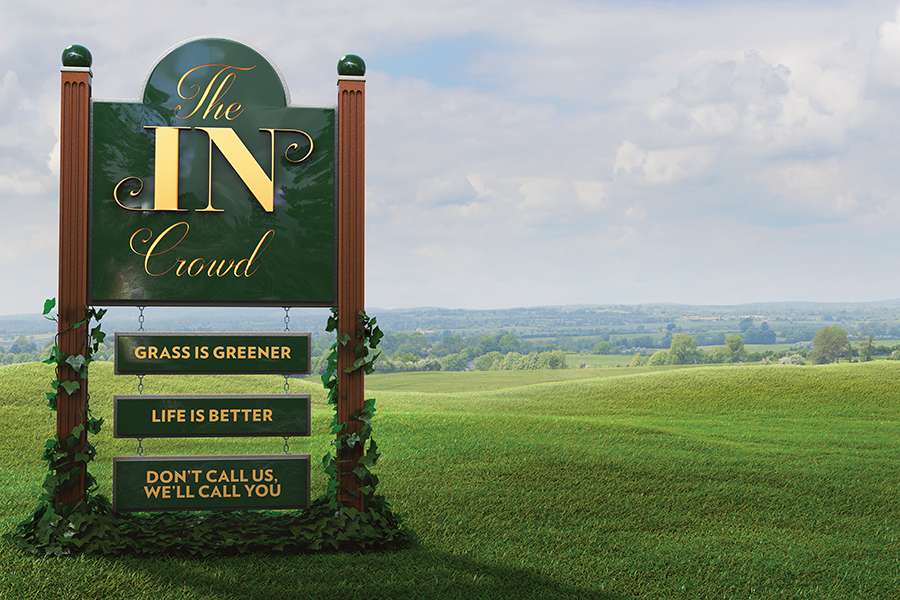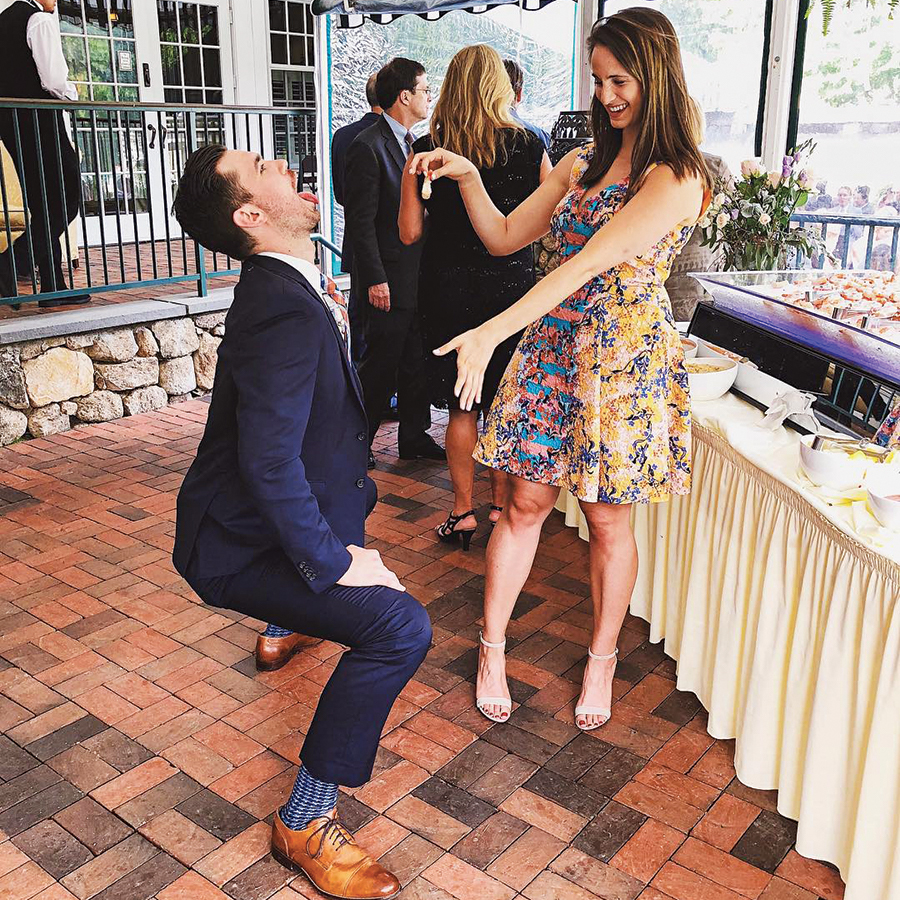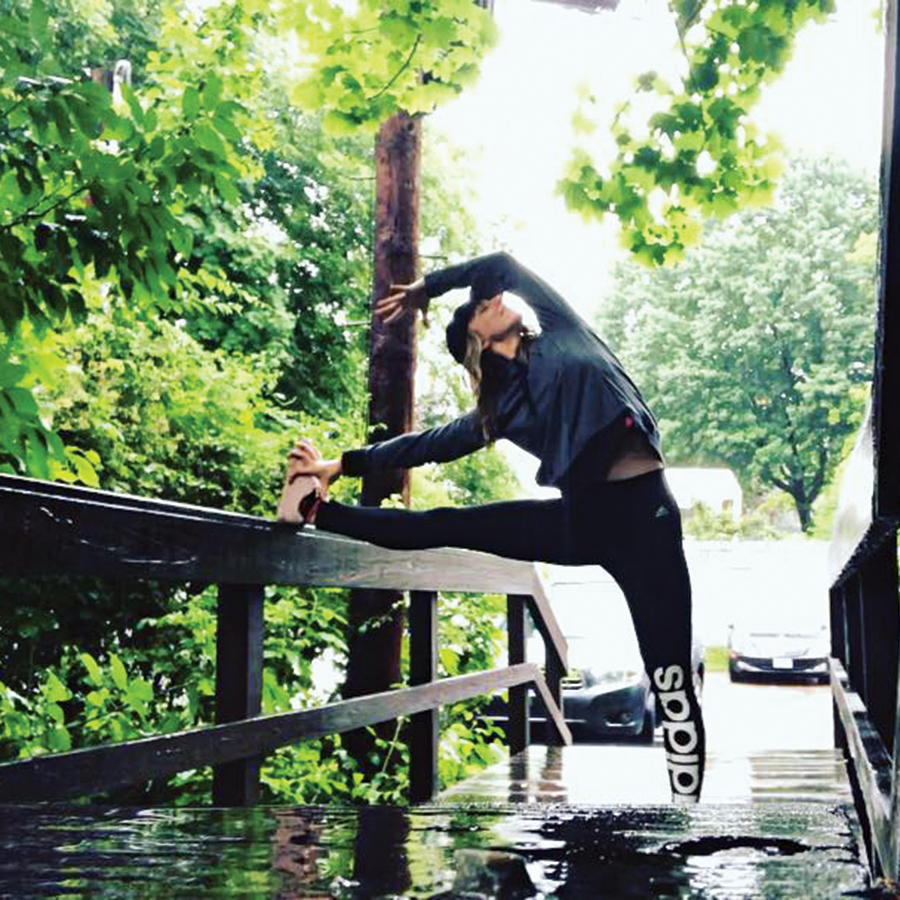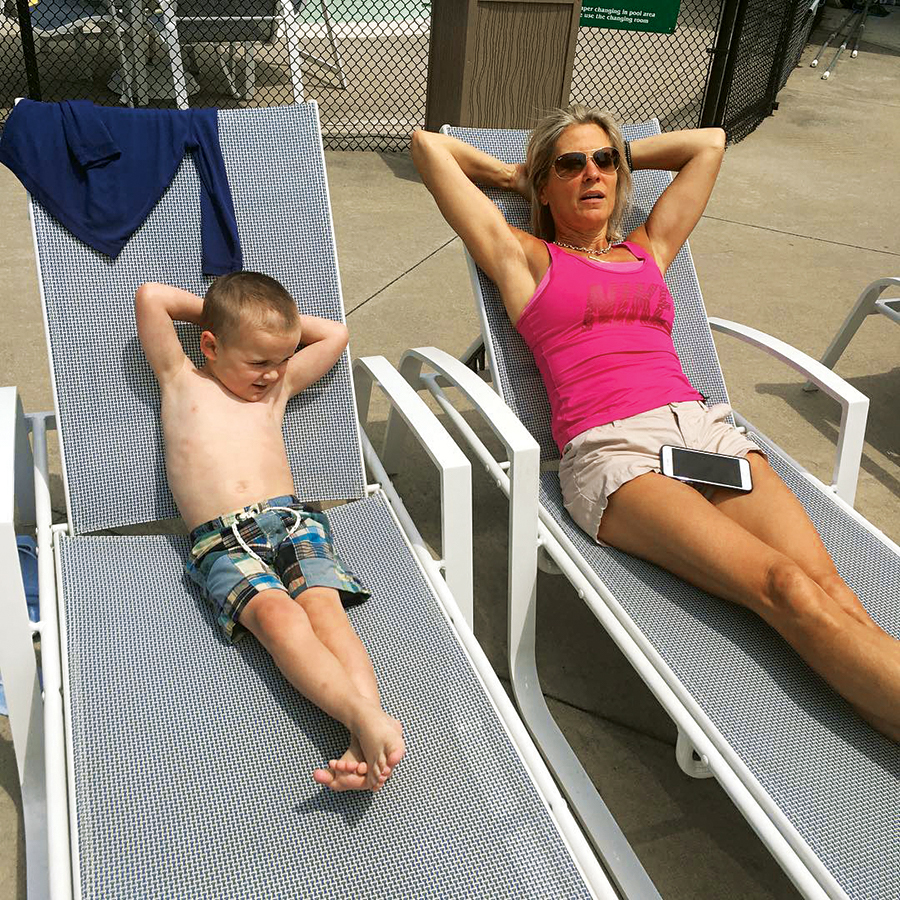The In Crowd: Inside Boston’s Elite Country Clubs
Lush greens, “Men Only” signs, and the best friends membership can buy. Think elite country clubs are a relic of an earlier era? Think again.

Illustration by Comrade
Myths about country clubs are far too easy to believe. They’re full of snobs! They’re all white! They keep out Jews! Cigar smoke! Backroom deals! Disdain for the common man! I promised myself I’d push aside those biases. But Mary Grace (not quite her real name) isn’t exactly helping. She is, I’m later told, a lovely person, the longtime widow of a financier. Right now, though, she’s clearly not pleased to see me.
It’s late morning on the first clear day of the sunny season. I’ve driven half an hour from Boston, traversing a picturesque suburban landscape. Full-canopied trees overhang a winding two-lane road, a forest rising on one side and a vast golf course unfurling below on the other. I pass white Colonials behind handlaid stone walls, each home a domestic idyll, like a snow globe in summer. Through a clearing I catch my first glimpse of the terraced grounds of the country club I’ve come to visit. As soon as I roll past the entrance, I find myself—or my station wagon, really—obstructing Mary Grace’s path. She is not happy.
Mary Grace, I have to say, looks straight out of central casting. She’s at the helm of a gleaming BMW convertible, the canvas top up, perhaps to preserve the shape of her neat white bob. The club is bustling today and the parking lots are full, so we’re circling and I’m apparently going the wrong way. She pulls her car around mine, pantomiming emphatically, glaring sternly. I laugh; I can’t help it. My first day at the club, and I’ve already managed to violate some unspoken rule, to transgress against decorum. And an elegant lady wearing a colorful polo shirt in a Beemer is letting me have it.
Did she know I didn’t belong? The word is loaded on the grounds of a country club. Over the past couple of months, I entered some clubs as a minor outlaw, trespassing on private property. Today, though, I hold a more purgatorial status: I am a member’s invited guest. So I belong here, though I don’t really belong here. Mary Grace does, though, and, clearly, she knows that I don’t.
When it comes to the matter of who’s in and who’s out, something on the order of one half of one percent of Greater Boston residents belong to elite country clubs. But the selection of those members isn’t as simple as skimming off the top layer of the economic hierarchy. The capital required to get in is social—nebulous, unquantifiable, and impossible to acquire, which is exactly the point. Some of Boston’s most famous have learned this lesson the hard way. Former Governor Deval Patrick tried to join The Country Club in Brookline—one of the area’s, and the country’s, most exclusive clubs—and found himself “blackballed,” as he wrote in his memoir. Tom and Gisele also tried to gain membership to Brookline—as those in the know call it. After a couple of years, they managed to get in, but not before provoking a row among the Brahmins. “We don’t want any thugs at the club,” one member told the Boston Globe. By being made to wait, the state’s first couple found themselves put in their place. None of this, of course, was new. Town & Country magazine once wrote, “In the course of [The Country Club’s] history, the list of people who have been turned away could well rival the fame of those it accepted.” You could hardly concoct a better recipe for mystique.
There’s little doubt that these are complicated times for country clubs. Our corporations, colleges, and cultural institutions, particularly in progressive Massachusetts, have cast their vote in favor of inclusiveness and diversity—not exactly country clubs’ traditional strong suit. Today, many members are all too aware that the culture views the institution they cherish as an anachronism—or worse. Already on the defensive, the country clubs’ admirers often viewed me with suspicion when I said I was writing about the institutions. It didn’t help that last year, one old-line club, Charles River Country Club in Newton Centre, found itself embroiled in a public controversy over alleged sex discrimination. Some local members increasingly feel like they are under attack. They are on their heels and digging in.
At the same time, just as many signs point to a club culture that is far from tipping into decline. Waitlists for full membership are years long. Membership dues are on the rise and members are proud to belong. Perhaps most important, thirtysomethings continue to apply and want in. At a wedding recently, a 31-year-old Boston corporate lawyer told me, unironically, “I’m a country-club man,” even though he is not, in fact, a member of one. He simply aspires to be a member soon, and he’s far from alone. The allure of Boston’s country clubs—some of our oldest and most durable institutions—seems not to have faded one bit. But as calls for inclusivity grow louder from all sides, how much longer can the party last?

Photo courtesy Thomas Gorecki & Alyssa Speranza

Photo courtesy Elyse Mickalonis, Yoga by Elyse

Photo courtesy Sara Russell
“You’re poking into a hornets’ nest,” a friend, who is a country-club member, warned me. “Have you ever seen a country club with an ad in the newspaper? They don’t do it. They want to be exclusive and hidden and not publicized.” You are not supposed to ask questions. The funny thing is, though, that even if the members are secretive, they are also—and this stereotype is true—very polite. After I got my hands on a partial list of members of The Country Club, I contacted dozens in hopes of an interview. A cousin of George W. Bush kindly texted, “How can I help you?” before he realized what I wanted and declined. A partner at the law firm Casner & Edwards thanked me for my interest but informed me that, regrettably, he could offer no input. A finance man named Nulsen (the names at The Country Club are exactly what you’d expect: Westy, Sandy, Ogden, Hap) struck a more fraternal tone: “Sorry, pal. I can’t talk about that.” They were unfailingly courteous (with the exception of one member of a different club, who accused me of engaging in a “witch hunt” and threatened legal action). But they were also intransigent: They would not invite me to Brookline.
I repeatedly tried to find friends of friends of friends who could get me past the gates. I repeatedly struck out. Frustrated, I turned to low-grade subterfuge. A former member of the club’s waitstaff suggested I enter through the service door. A gentleman, who had reason to know, informed me that the gatehouse was often unmanned. A handful of people, who had no reason to know much of anything, gave me the obvious and unhelpful tip, “Act like you belong.” Chickenshit, I choose a gray, unseasonably cool day on the theory the club will be less crowded and drive to Brookline to break in.
You could drive past The Country Club a hundred times without realizing it’s there. The entrance, an open driveway flanked by hedges, is marked by nothing more than a small, green sign camouflaged in the foliage that reads, “The Country Club, AD 1882.” I nose into the driveway, glimpse the gatehouse and—shit—see a dark shadow in the window. A sign cautions “Members Only,” but as I inch forward, clearly not a member, the man in the window doesn’t move. Closer still, I realize he is not a man at all, but a plywood, human-shaped cutout dressed in a natty suit—a scarecrow for plebeians. I crawl past him as a Mercedes S-Class rolls by in the opposite direction.
A tunnel of trees shades the driveway. Emerging on the other side, onto a close-cropped fairway, I make out through the fog a foursome of golfers clustered around a bright-yellow flag on the green. Above me on a knoll, the vast, yellow Colonial clubhouse comes into view. I feel as if I’ve passed through a portal not just in space, but in time. I park and start across a grassy quad, surrounded on three sides by hulking yet elegant buildings: a domed complex of indoor tennis courts, another yellow Colonial, and, at the far end, a sprawling red-brick building that, for some reason, piques my interest. Two well-built men in their thirties, golf pros, I imagine, are coming toward me. I remember a tip from the former waiter: Staffers are supposed to know every member, so even if they don’t recognize you they might not risk saying so. I try my best member impression. Did I just puff my chest? Yes, yes I did. They nod as they pass. The one nearer to me turns his head almost imperceptibly, as if tracking me. Then they’re gone, and I feel an almost-comical sense of relief.
I walk up the red-brick building’s steps. Nailed to the front door, an engraved brass plate reads, “Men Only.” I turn the heavy knob, push through the door, and the sensation of having passed into another time grows stronger. Down the hall, I find two saloon doors that swing open into a pub. Behind a thick wood bar, two young men in black slacks, crisp white shirts, and tailored vests are waiting to serve. A golf tournament plays on a flat-screen TV, the lone incursion of modernity. I wander through a sitting room. Everything is fancy but decrepit: plush chairs with faded upholstery, creaky floorboards, wood-paneled walls that dully reflect light but don’t quite gleam. This is a uniquely Yankee aesthetic only achieved through the investment of vast sums of capital long ago.
Like so much in American history, country clubs got their start around Boston. In 1882, China trader James Murray Forbes invited friends to his Boston townhouse and proposed forming a club. In fine Brahmin style, he couched it as a modest pursuit. “The general idea is to have a comfortable club-house for the use of members with their families,” a brief prospectus read. But the concept—a single institution that could offer both Old World luxury and a stamp of social approval for members of America’s fledgling aristocracy—was an instant hit. The Country Club’s membership rolls filled; the club’s leaders helped found the U.S. Golf Association, and they’ve hosted the U.S. Open now and again. (The club will do so for the fourth time in 2022.) Then came the imitators—built by those who hadn’t made the first cut.
Myopia Hunt and Essex were next, both 19th-century Brahmin redoubts that are among the only ones that can credibly claim to be near The Country Club’s level of cachet. Then the clubs proliferated: Winchester, Brae Burn, and Vesper opened in the decades before the first World War. The city’s most prominent Jews—wealthy but socially marginalized—struck out on their own, building Kernwood Country Club, a luxurious retreat on the North Shore that rivaled the best the Gentiles had to offer. Other clubs earned reputations as predominantly Irish or Italian. Every tribe with access to capital had its home. Today, within an hour’s drive of Boston, there are almost three dozen country clubs that Gary Larrabee, a historian of local country clubs, designates as “five-star,” which is to say, exclusive, expensive, and private.
Getting in, it turns out, is not just a matter of having a handsome address and a plump bank account. As one member of an elite club told me, the club approaches you, not the other way around. It’s a time-honored tradition that, once you’re approached, your job is to do nothing. Advocating on your own behalf or bringing any attention to your potential membership is seen as gauche, even desperate, and a sure sign that you don’t belong. Another unspoken rule, perhaps the most important one, is that club business is handled by club members, on the inside. It’s like the mob’s omerta, but with polo shirts and tennis skirts. “The club is my family,” says Susan Hayes (not her real name), a member at Charles River. “Every family is dysfunctional, and you love ’em more than anything. But I never take my family’s dirty laundry outside the house.”
Still, members will say, not every protocol lasts forever, and changes from within have slowly taken hold. A hundred years ago, it would have been unthinkable for The Country Club to admit Jews or Italians, to say nothing of African-Americans. Today, it would be a disgrace not to have some degree of diversity in the membership—and nearly all Boston-area clubs do. The Country Club, which opened up sooner than many of its WASP peers, admitted a Jewish member in the late 1970s and a black man around 1990. The change was a slight but necessary correction to align with the times. “Clubs are a reflection of society and not vice versa,” a member of an elite club told me. You mean they follow changes in the broader culture? I asked. “Yeah,” he replied, “or they’ll die.”

Photo courtesy Kelly Bennett
\Photo courtesy instagram.com/thefullenglishbreakfastBefore going any further, there’s one not-so-dirty secret that I need to acknowledge: Country clubs are nice. That’s why Boston’s wealthiest shell out $30,000 to $100,000 and more to join. They are, quite simply, cocoons of luxury. In the parking lot of any exclusive club around Boston, you are likely to find more Teslas than Toyotas by a mile. Artful landscaping, stone paths, and Photoshop-green lawns are all around. (Some clubs spend more than $2 million a year maintaining the golf course alone.) Smartly dressed hosts, waiters, and pro-shop clerks greet members by name—last name, of course, preceded by the appropriate honorific. Get a drink, order lunch, sit where you like: in the dining room, at the pub, on the deck chairs. After all, everything you see is quite literally yours.
Prowling around the grounds is one thing. To experience the real luxury of a country club, though, you need to see it in action, from the inside. In other words, I needed a guide. Enter a man called Doc who, since the Nixon administration, has belonged to an old-line WASP institution, not as prestigious as Brookline, but not far off. “How do you want to do this?” he said on the phone. “I’ve got time. I’m retired.” I meet him on a perfect summer day in the clubhouse’s cool, dark lobby before he treats me to a leisurely afternoon of country-club relaxation. Or as he likes to call it, a typical Wednesday.
Within moments of arriving, one thing immediately becomes clear: Everyone here knows Doc. A distinguished maître d’ in what I’ve come to recognize as the country-club staff uniform—black slacks, white shirt, black vest—greets him as we pass the dining room, where a women’s luncheon is under way. In the pro shop, a young man asks Doc if he’s still “on the mend” from an injury that’s kept him off the links lately. Then we’re off for a drive around the course, bumping into friends along the way. “It was nice when we had a private club, eh?” jokes a retired accountant who looks around Doc’s age. It turns out that the women at the luncheon are non-members; they don’t belong. At the caddie shack, Doc settles a lost Super Bowl bet with a younger man who happens to roll past in a golf cart. “Hold on,” Doc says, peeling off a 20 to pay the wager. “You’ve got a good memory, Doc!” the winner says with a chuckle.
Within certain bounds of decency and good taste, a country club can be anything members want it to be. For Doc, it’s easy collegiality, a place to golf with his son, and access to a vacationland just minutes from his home. For other members of local clubs, it’s about being social. Hayes says the club is like a fraternity or sorority. “[My husband] and I go over there for dinner,” she says, “and we end up at a table for eight.” Ask members in their forties and fifties why they keep shelling out annual dues, and you’re likely to hear about their kids. “Some of my boys’ best memories will be here,” says Ralph Reichle, a radiologist with two teenage sons, as we stroll the grounds of Nashawtuc Country Club in Concord. His sons grew up spending their summers here, usually on the pool deck, which, every day, is alive with kids shouting and doing cannonballs. The grounds are private and the parents, waitstaff, and lifeguards all know one another, so members feel comfortable leaving their kids unattended to chat, play tennis, or even head to the bar.
My afternoon with Doc ends in what is unofficially known as “the 19th Hole,” a men-only dining room attached to the men’s locker room. The bartender is attentive and knows everyone by name. Doc regales me with tales of his years in the military during Vietnam. (He once removed a man’s appendix on a ship during a storm.) One member starts in on wife jokes, telling his buddy that he has good news: He’s no longer allowed within 10 feet of his spouse because a new medical device in one of her ailing body parts would blow up his pacemaker. At another table, the talk turns to politics. “Trump is right!” one man says. “He should have fired all of them!” his tablemate chimes in. This is it—this is country-club life, at least on a weekday afternoon: backslapping, cold beers, and mildly loose talk without fear of anyone on the outside overhearing (sorry, boys!). It’s a safe space for the wealthy, an oasis in the ’burbs where, for once, members can just relax.
That’s the idea, at least. Still, from time to time, there’s trouble in paradise. Last spring, just before the golf season began, the Charles River Country Club in Newton Centre unveiled the latest phase of its multimillion-dollar, multi-year renovation, converting a tired old WASPs’ nest into a clubhouse to rival any in the region. The River, as members call it, is a golfer’s golf club, home to some of the best amateurs in the area. Cam Neely, president of the Bruins, and Ed Deveau, the former Watertown police chief, are among its members. The atmosphere is often described as jovial—like one ongoing party for grownups. “It’s fun!” Hayes says. “If you had a bad day, someone’s there to make you laugh.” But one component of the recently completed construction threatened to burst the club’s carefree bubble. An estimated $1 million or more of the project’s budget had gone to renovating the men’s locker room, including a fully stocked, fully staffed bar and grill. At the time, no women served on the club’s board of directors.
One member—later described by club management as a disgruntled whistleblower—took exception and filed an anti-discrimination complaint with Attorney General Maura Healey’s office. A complaint was also filed with the Alcoholic Beverages Control Commission, which has the power to enforce anti-discrimination laws in establishments that serve booze. Boston Globe columnist Shirley Leung also received a copy. That’s when all hell broke loose.
Leung ran two columns that torched the place. “Sexist Grill Still Par for the Course at Charles River Country Club,” blared the first headline. In response, members hired former Mayor Tom Menino’s one-time communications ace to handle crisis PR. In Leung’s next column, she included a juicy new detail: Up until the time that her first piece on the River club ran, a sign had hung above the men’s bar that pointed out, oh so helpfully, that “A woman can only get SO mad.”
This was hardly the first time the issue of equality disrupted life behind the gilded hedges. In 1995, nine female members of Haverhill Golf & Country Club sued, alleging pervasive discrimination against women. They accused Haverhill of prohibiting women from playing golf on weekend mornings (prime time for serious golfers) and barring women from certain parts of the clubhouse, such as a card room and a grill. After they sued the club, they discovered the board had been manipulating membership waitlists to allow men to leapfrog women. The club doubled down, fought the allegations in court, and, after a five-year legal battle, lost spectacularly. A judge put the club under direct court supervision and a jury awarded the women more than $1.9 million in damages. After the decision, the women’s lawyer, Marsha Kazarosian, received calls from women at other clubs across the country.
The judgment sent a panic through Boston’s tight-knit country-club world. (An official memo from the National Club Association soon circulated among club managers with tips on how to avoid legal exposure without significantly changing any policies.) Inside Haverhill, the reaction was swift and the women soon faced the ultimate country-club punishment: ostracization. According to the New York Times, a real estate broker lost clients, while her husband, an insurance agent, saw part of his business dry up. Another plaintiff’s husband found his name crossed off a list for a golf league. “Most of the women supported us until it got hot and heavy,” says Karen Richardson, one of the women who sued Haverhill. “Then the husbands put pressure on them.” One female member, who had supported the campaign, broke down sobbing in the locker room, Richardson recalls. “Afterward she was fine with us personally, unlike some of the women, who shunned us.”
Twenty years later, similar policies protested at Haverhill remain on the books at many other Boston-area clubs. The Country Club, for instance, has its men-only bar (which members explain is part of the men’s locker room). At many, perhaps even most, clubs, only one person per household is permitted to vote on club matters. This person is the “A,” or primary, member—and the one with full privileges. Although a married couple is free to choose who gets A status, the A member is almost always a man. Even Nashawtuc, a relatively progressive and open club that integrated its après-golf grill more than 20 years ago and extended voting rights to spouses, still bars women from teeing off on Saturdays before 10 a.m. (Tuesdays before 11 a.m. are reserved for women only.) “I’m not surprised” that clubs still have these policies on the books, says Micki Meggison, president of the New England Women’s Golf Association. “It’s disappointing, but they’re private, so they can get away with that kind of discrimination.”

Photo courtesy Matthew K. Scott

Photo courtesy Kellyann
Williams
After the Globe columns ran, officers and prominent members of Charles River rushed to the club’s defense. The general manager and Ed Deveau, who was club president at the time, gave investigators from the Alcoholic Beverages Control Commission a tour of the clubhouse, and three female members sat down with the investigators and said they experienced no discrimination at the club and that the new men’s grill was not a problem. One or two of the women wrote a letter, ostensibly to the Globe, defending the club. The club shared a copy with the ABCC’s investigators, but the letter was never actually sent to the newspaper. More publicity was not the goal. Meanwhile, rumors swirled among members about the identity of the traitor. One woman, fearing that other members had identified her, called the ABCC for reassurance that the complaint didn’t have her name on it.
Hayes, a single-digit-handicap golfer who proudly advertises her company as “woman-owned-and-operated,” views the whole thing as unfair publicity. “I don’t view myself as a second-class citizen at Charles River,” she tells me, and she is happy to let the men unwind in their grill after golf. “If they want to have a few chuckles after a long week of work, okay,” she says. “I don’t lose sleep over that.” Besides, she adds, the rules shouldn’t be a surprise. “I knew [the rules] when I was joining.”
A Jewish man, meanwhile, told me he has been a member of various historically WASP country clubs for decades and has never felt discriminated against. But, he added, if the private clubs had wished to discriminate against him, they would have had every right to do so. This kind of thinking may not represent the majority these days, but it’s among the main reasons that clubs remain as strong as ever. A young software industry professional who is black and regularly played golf at an exclusive club in the Boston suburbs says there were tensions along racial lines there. “It’s not like this is a happy, open place for everybody,” he says. But he feels it goes with the territory and still intends to join. Above all, he wants a nice place to play golf. “I don’t have a girlfriend and I don’t have children,” he says, “so I can suck a lot of this stuff up.”
From inside the tent, there’s little reason to overhaul club culture and policies. Most members are happy. Young families still clamor to join. Outrage over country clubs flares up in the outside world from time to time, which can be a headache, but little more. Why on earth would they change any more than they have to?
In April, an ABCC investigator determined that the River’s men’s grill didn’t violate the relevant rules because it was inside the men’s locker room—a space where exclusion on the basis of gender is allowed. Frustrated, Leung’s tipster sent her another note. “[N]othing was done,” the source lamented. But the tipster was wrong. Something had been done: The club had dealt with it. Members had banded together to protect the club. They’d made their case to the state and, whether intentionally or not, let the whistleblower know that he or she had stepped out of line. Leung published a third column, embarrassing the club once more but producing little, if any, lasting effect.
On a recent Saturday afternoon, I tuck a polo shirt into a pair of khakis and walk through a door at the River that reads, “Men’s Locker Room.” I find myself in the fully operational men’s grill. It is quite nice: high ceiling, full bar with mirrored shelves, and waiters standing by. It’s also buzzing. Every table is occupied by gents in pastel golf shirts. “How are ya?” a member bellows as he claps his pal on the shoulder. There is no sign of discord, no sense of siege. The “SO mad” sign of Leung’s column is gone, but equilibrium has been restored. As I take in the scene, I can’t help but notice that I do not, in fact, seem to be inside a men’s locker room. The actual locker room is on the other side of a wall—separated from the dining room like the bathroom of any public restaurant. But no matter. The state and many of the club’s female members are satisfied with the arrangement. The crisis has passed. And the party roars on.


